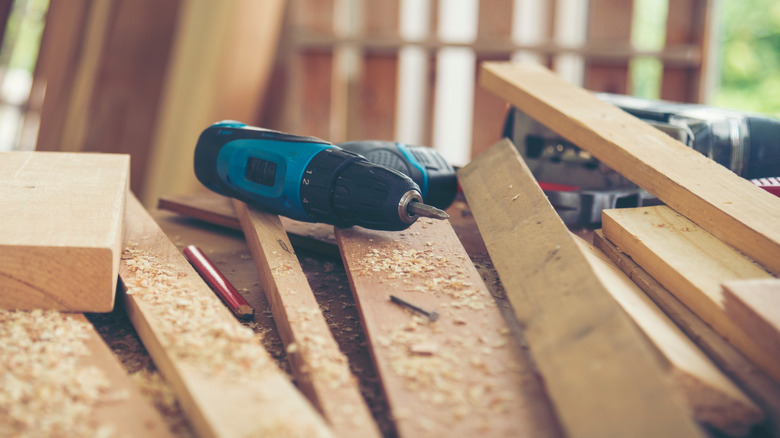This Low-Cost DIY Creates The Perfect Eye-Catching Accent Wall For A Boring Room
Experts want you to spend $150 on your accent wall. Crafty folks know you can do it for 1/10th of that.
If crafters know anything better than the experts and pros, it's how to give materials a higher purpose. Ask a professional at a lumberyard what furring is for and you'll get a litany of predictable answers: installing corrugated metal walls, nailers for casework and trim, creating air gaps so radiant barriers actually work, and many more. This, of course, misses all the creative ways in which furring strips — inexpensive, often sketchy-looking 1x2, 1x3, and 1x4 boards — have been used by people who don't care much about radiant barriers.
Normally, you might use furring to make a grid on which you'd hang pegboard. You could also create something like a wood pallet accent wall. However, one of the more creative uses is to create a pattern of slats to spice up an accent wall. Actually, it's not really only one creative use, but dozens — executed by people who get frustrated at the pros for buying all the straight furring and leaving a bunch of hockey stick-shaped boards destined for the cull lumber bin. "What on earth," you hear them crying out in the lumber aisle, "am I going to make my eucalyptus LED sconces of?" We'll look at some of those alternatives, but first let's look at the general approach to making an accent wall with furring slats.
Making sticks into a digital waveform
When you see it, it's hard not to think of TikTokker @thenavagepatch's $15 slat accent wall as a digital audio waveform, one of those mysterious music visualizations you see when you're listening to stuff on a computer. There's something elemental and satisfying about the idea of making such a thing of rough, ill-mannered wood like furring. Whatever his abstract or representational intention, though, the actual execution is simple, and involves no visualization software of any kind. He cuts $1.48, 8-foot boards of 1x2-inch into various lengths, then sands and stains them (using Minwax Special Walnut). Starting at the top of the wall (though you could as easily start at the bottom), he attaches them to the wall with brad nails, occasionally adding a dab of construction adhesive when the slat at hand is too short to reach a wall stud. The pattern isn't quite random, as it instead seems to rise and fall like the breath of a singer or asthmatic, rarely moving directly from the longest to the shortest board.
Each furring strip is spaced ¾ inch from the next using a scrap or block of wood that is destined to become a shelf sticking out from the gaps between slats. He checks for level frequently because this design has to be very regular to work. Then the brad nail holes are patched and sanded. Finally, shelves are pushed in between the slats in more or less random locations, with a shelf-width scrap glued and tacked to the slat below for support. Easy-peasy, right?
Your furring wall art dreams don't have to stop there
@thenavagepatch's waveform design isn't the only way to make an accent wall with decorative slats, though it is a natural application and you can actually buy framed waveforms made in a similar way. Longer furring is a different look with more room for shelves. The design can be applied to both the right and left sides of the accent wall. It can be mirrored in a corner so that the same slat shape appears on both left- and right-hand walls (this design is particularly good for supporting shelves). And you can make a much shorter mirrored segment to create a little corner design element that isn't quite so dramatic. They don't even have to be horizontal: Attach the furring vertically, starting at the ceiling, for a different look.
Space them closer together if you really want to cultivate the audio waveform look. Using a program like Audacity, you can record yourself saying "I love you" or "astronauts found no cheese" or whatever, and make your furring match the resulting waveform. It's probably possible to overlap two or more series of slats in layers to give the design some depth, perhaps for something like a mountainscape. And there's no reason you can't cover the entire wall with slats, other than the fact that there are much cheaper ways to accomplish that particular effect.

